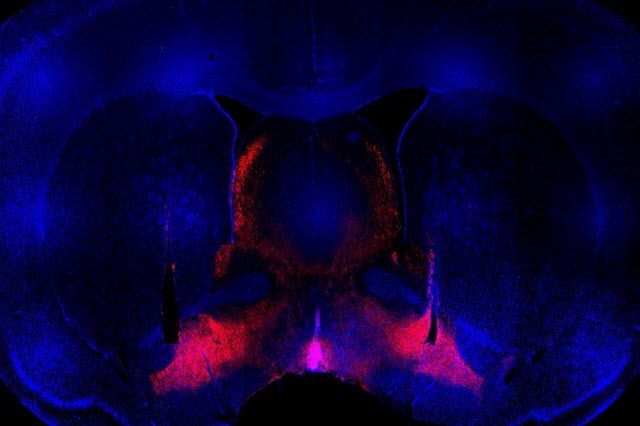 A view of a rat’s brain; the ventral pallidum, where researchers showed that binge behavior can be suppressed, is in the red-stained roughly triangular areas toward the bottom.IMAGE CREDIT: JOCELYN RICHARD/JOHNS HOPKINS UNIVERSITY
A view of a rat’s brain; the ventral pallidum, where researchers showed that binge behavior can be suppressed, is in the red-stained roughly triangular areas toward the bottom.IMAGE CREDIT: JOCELYN RICHARD/JOHNS HOPKINS UNIVERSITY
Rats that responded to cues for sugar with the speed and excitement of binge-eaters were less motivated for the treat when certain neurons were suppressed, researchers discovered.
The findings suggest these neurons, in a largely unstudied region of the brain, are deeply connected to the tendency to overindulge in response to external triggers, a problem faced by people addicted to food, alcohol, and drugs. The findings are available online in Neuron and will appear in the June 15 issue of the journal.
"External cues—anything from a glimpse of powder that looks like cocaine or the jingle of an ice cream truck—can trigger a relapse or binge eating," said Jocelyn M. Richard, a Johns Hopkins University postdoctoral fellow in the Department of Psychological and Brain Sciences and the report's lead author. "Our findings show where in the brain this connection between environmental stimuli and the seeking of food or drugs is occurring."
First researchers trained rats to realize that if they heard a certain sound—either a siren or staccato beeps—and pushed a lever, they would get a drink of sugar water. Then, as the rats performed the task, researchers monitored neurons within the ventral pallidum area of the rats' brains, a subcortical structure near the base of the brain.
When the rats heard the cue linked to their treat, a much larger-than-expected number of neurons reacted—and vigorously, researchers found. They also found that when the neuron response was particularly robust, the rats were extra quick to go for the sugar. The researchers were able to predict how fast the rats would move for the sugar just by observing how excited the neurons became at the sound of the cue.
"We were surprised to see such a high number of neurons showing such a big increase in activity as soon as the sound played," Richard said.
Related Article: Biologists Apply Optogenetics to Cancer for the First Time
Next, the researchers used "optogenetics"—a technique that allows the manipulation of cells through targeted beams of light—to temporarily suppress the activity of ventral pallidum neurons while the rats heard the sugar cues. With those neurons inactive, the rats were less likely to pull the sugar lever; when they did pull it, they were much slower to do so.
That ability to slow and calm the reaction to cues or triggers for binges could be key for people trying to moderate addictive behaviors, Richard said.
"We don't want to make it so that people don't want rewards," Richard said. "We want to tone down the exaggerated motivation for rewards."











